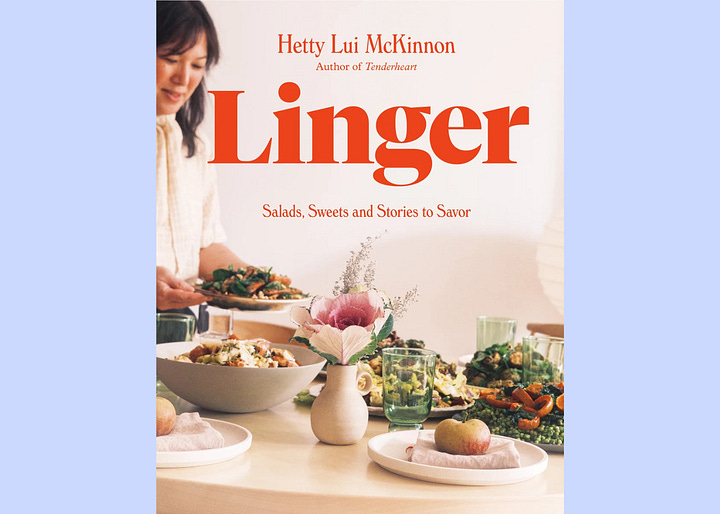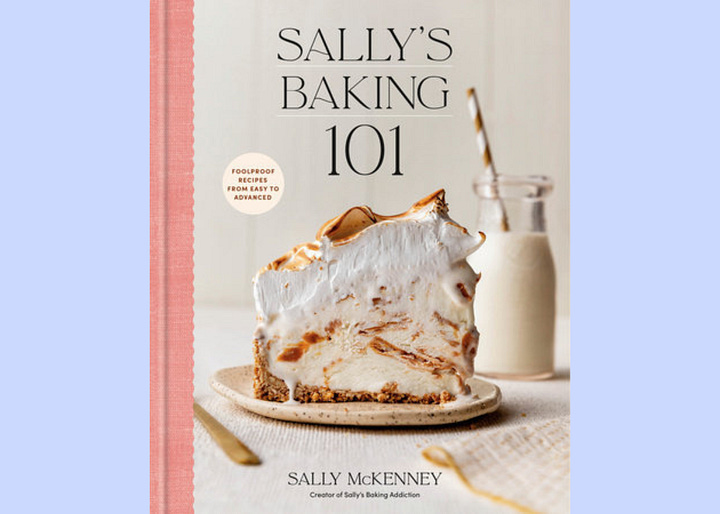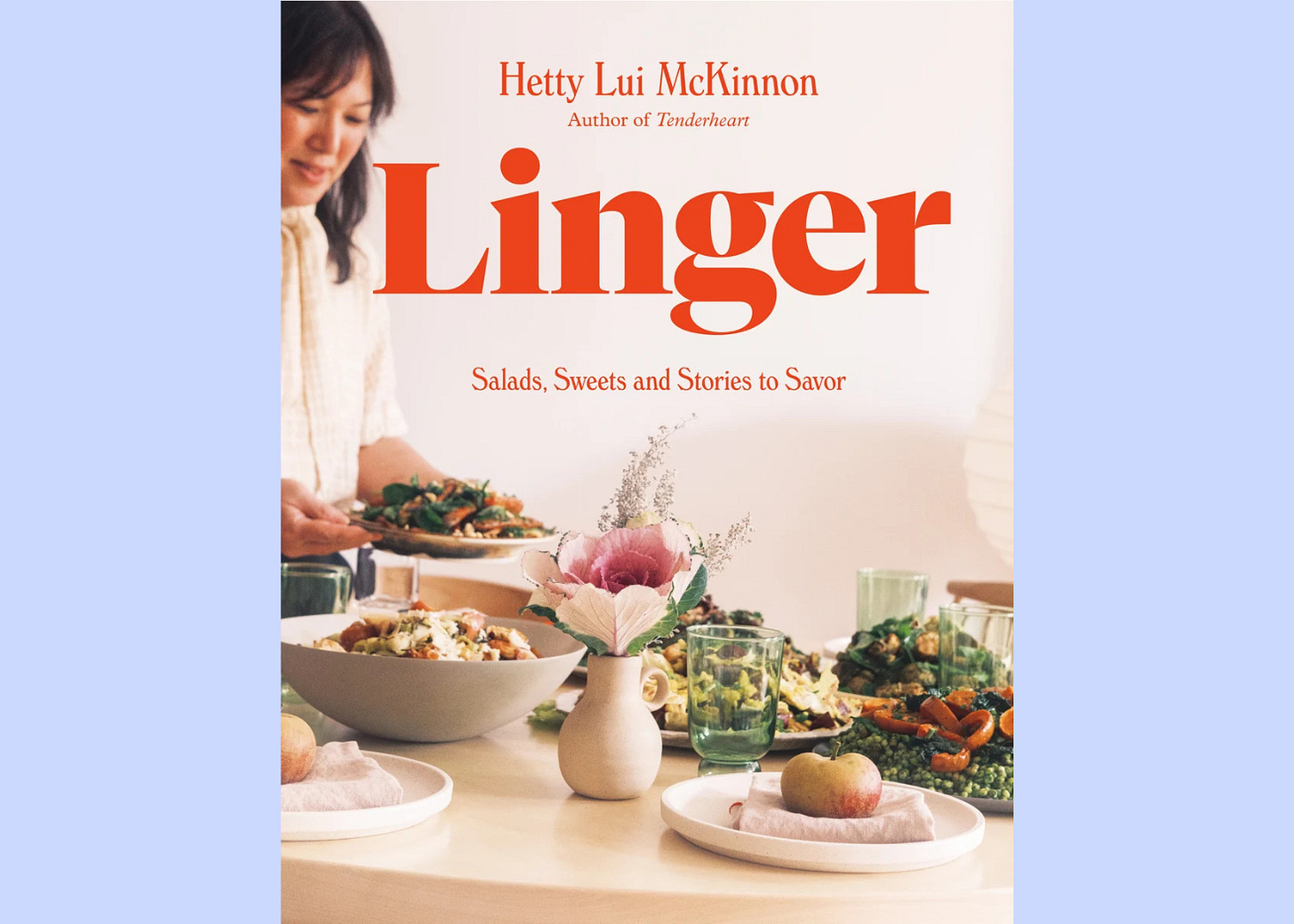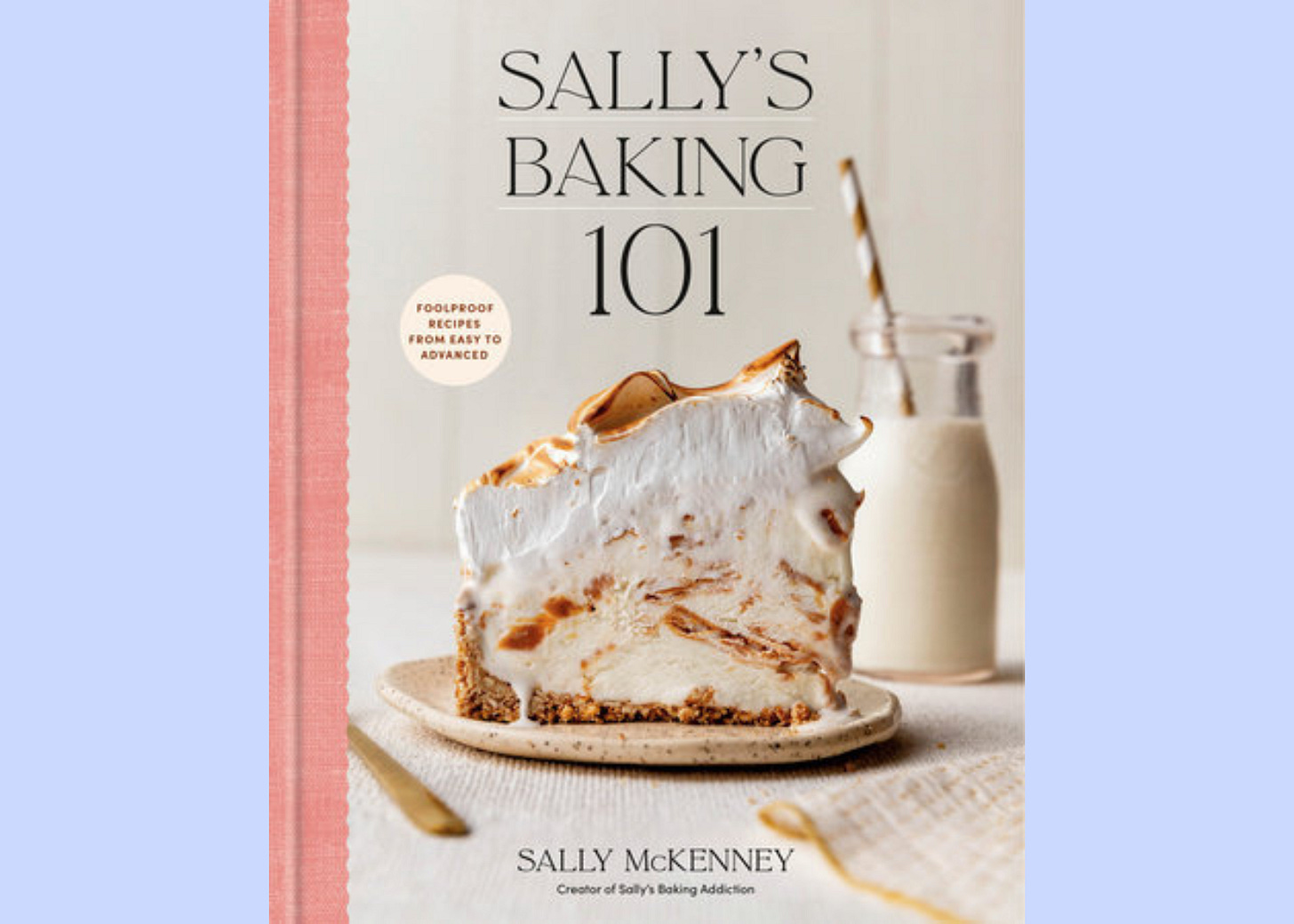



*Linger, by Hetty Lui McKinnon
As the mother of three young children, Hetty Lui McKinnon started her culinary career by making and delivering salads from her bike basket in Sydney, Australia. Although she moved well on from salads—becoming an award-winning cookbook author and frequent New York Times contributor—McKinnon retained her love for salad and a vision of how sharing salads around a table could bring people together to linger and find community, especially post-pandemic.
Now, in Linger, a warm, gentle book, McKinnon offers about 100 recipes for salads of all sorts, with an “anything can be a salad” take on the word. (Sadly, the book offers few new takes on her delicious dumpling salads, such as this summer-perfect dumpling tomato salad; there’s no entry “dumplings” in the index, but there is one recipe.)
Twelve chapters each provide a complete menu, generally serving four to six people, though cooking any of these menus would be a feat for most hosts, with recipes for around seven salads plus desserts and breads. (McKinnon writes that she expects most people will cook the recipes singularly.) Each chapter opens with a quietly thoughtful, personal essay and a QR code to a playlist curated by her daughter.
The first menu, for example, includes ginger-roasted kabocha with black rice and ginger-miso dressing; a vegan prosperity toss; charred gai lan with black-eyed peas and chile crisp vinaigrette; curry potato and pea dumpling salad; yo po spicy rice cake salad; soba noodles with crunchy vegetables and fu yu sesame sauce; and hot and sour potato salad.
Although McKinnon says in the introduction that one benefit to salads is they can be largely prepped ahead of time, she offers few do-ahead pointers in most recipes or any day-by-day timetable for preparing so many dishes. While the recipes are rarely complicated, not all the ingredient lists are short nor the work quick—those dumplings, for example, are homemade, not purchased as in the Times tomato salad. (Also, why in a menu of recipes that mostly serve two to four, does the dessert serve eight? Generally, the menu concept felt like it came close but didn’t quite work here.)
Those issues aside, these are, as usual for McKinnon, recipes that will propel many cooks straight to the stove. Oyster mushroom shawarma with farro and lemon cashew cream; fennel salad with pickly dressing (with fennel, apple, grapes, almonds, and raisins); pan-fried mapo tofu salad; bibimbap-style gnocchi with gochujang vinaigrette; peaches and cream with chile crisp; Gruyère, jalapeño, and scallion mochi balls; black sesame tofu Basque cheesecake; and tofu bread rolls make up a very short selection of the eye-catching, mouth-watering recipes here.
The Complete America’s Test Kitchen TV Show Cookbook, 2001-2026, by America’s Test Kitchen
I felt weary just looking at this book, even before hefting all 7 pounds of it. With 1,400 recipes and all the product recommendations from 2001 to a year we haven’t even gotten to yet, in a small point size despite taking up 1,120 pages, this might stay on the shelf more often than not. But the show’s many devoted fans may be thrilled to have every single thing they ever saw in one reference book.
The recipes, while rarely cutting-edge, are reliable, provide useful troubleshooting advice, and often feature interesting, well-tested tweaks, such as brining ground meat in baking soda and salt to keep it tender and juicy, or briefly cooking fried chicken in minimal oil before finishing it in the oven (but if you’re a Southerner who knows good biscuits, skip the misbegotten tweak of melted butter in the breakfast chapter). And, if you’ve been reading anything else on Cook These Books, you’ll guess how I felt about the inconsistency in measures, with some recipes using cups and table/teaspoons only, and some also including ounces for some but not all ingredients (such as chocolate hazelnut spread, offering weight by ounces for the sugar and cocoa but not the nuts).
That homemade Nutella was fine but not outstanding; go well beyond the time given in the final step of processing to get a truly glossy spread, for the best texture. The choice of bread flour instead of all-purpose was a good one in the no-knead brioche dough (tested in brioche à tête instead of full loaves). Although it’s a no-knead dough, don’t skip the folding steps for a tighter crumb.
*Sally’s Baking 101, by Sally McKenney
I ended up of two minds about this book. While the recipes were decently detailed, sometimes more so than usual, and were labeled by skill level, it didn’t really seem to deserve the “baking 101” moniker.
The opening recipe, for chocolate chip cookies, includes a tips for success section, but that isn’t standard. In many places new bakers would appreciate more tips, such as the recipe for pepper-Parmesan cookies, which calls for rolling the dough into a slice-and-bake log. As simple as these always look, the logs can be frustrating—no matter how well you think you’ve rolled a compact, perfectly round log, you can end up with center fissures and lopsided, sort-of square cookies.
But many of the standards are here—shortbread, strawberry crumb bars, cheesecake squares, brownies, sugar cookies, marble cake, apple pie with salted caramel sauce, lemon curd tart, popovers, bagels, rough puff pastry dough, cinnamon swirl quick bread, and banana Nutella muffins, stromboli, and cinnamon raisin swirl bread.
*Plant to Plate, by Gaz Oakley
From a kitchen garden in Wales, Gaz Oakley has focused in his first cookbook on commonly grown vegetables and fruit, including carrots, tomatoes, potatoes, zucchini, beets, apples, and strawberries. Even if your kitchen garden is actually the local farmers market or supermarket, you’ll find recipes to take your imagination far afield from everyday produce.
A strawberry and watermelon salad tosses the fruit with a paste of onion, ginger, tahini, za’atar, miso, chili flakes, and vinegar, then bakes the fruit to concentrate the flavors before serving them over pearl couscous mixed with green tomatoes and pistachios. Homemade dried strawberries and dried lavender flavor stovetop-cooked Welsh cakes (somewhat akin to a scone).
Hummus, steamed spinach, and spice-infused milk flavor mashed potatoes topped with black beans cooked with, among other things, cumin, oregano, thyme, bay, celery salt, ancho chilies, soy sauce, miso, and dried mushrooms. Taking inspiration from massaman curry, cream of tomato soup is far from the ordinary, flavored with fennel and lemongrass as well as ginger, cumin, coriander, cinnamon, cardamom, nutmeg, peanut butter, nori, and coconut milk (again, among other ingredients!).
Or how about a beet and cardamom “ice cream” made from coconut milk and flavored with maple syrup? Oakley includes many recipes for fermented foods, such as tomato and nasturtium kimchi, fermented nut (think cashew “cheese”) stuffed squash flowers, and strawberry kombucha.
*I haven’t tested any recipes in this book.
Disclosure: I am an affiliate of Bookshop.org, which supports independent booksellers, and I will earn a commission if you click through and make a purchase on any of the titles above.





